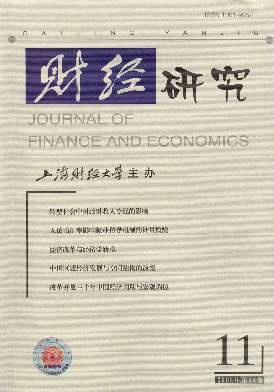外商技术转移、创新激励与东道国引资政策——走自主创新道路,我们能依靠外国技术吗?
财经研究 2008 年 第 34 卷第 11 期, 页码:123 - 134
摘要
参考文献
摘要
文章在累积创新框架下建立一个附加拍卖的动态博弈模型,研究东道国企业利用外商技术转移实现技术升级的微观机制,以及东道国政府旨在改善社会福利的引资政策。研究后发现:对于核心技术,外商总有激励进行技术封锁;对于一般技术,外商愿意将其技术许可给东道国以赚取垄断利润;东道国企业只有坚持自主创新才能获得技术模仿的机会并最终突破外商对核心技术的封锁;若东道国政府能使外商将核心技术授权给本国企业,本国企业将绕过自主创新从而直接进行模仿创新,若不能有效控制外商技术转移方式但可对仅转移设备等"硬"核心技术的方式采取有效限制,可降低潜在技术模仿成本从而减少东道国激励本国厂商进行创新的补贴成本。最后,文章讨论了我国利用外资推动技术升级的方式。
[1]王子君,张伟.外国直接投资、技术许可与技术创新[J].经济研究,2002,(3):69-75.
[2]Baye M R,Kovenock D,de Vries C G.Rigging the lobbying process:An application ofthe all-pay auction[J].The American Economic Review,1993,83(1):289-294.
[3]Baye M R,Kovenock D,de Vries C G.The all-pay auction with complete information[J].Economic Theory,1996,8:291-305.
[4]Das S P.Direct foreign investment versus licensing[J].Review of Development Eco-nomics,1999,3(1):86-97.
[5]Dunning J H.International production and the multinational enterprise[M].London:George Allen and Unwin,1981.
[6]Kim L.Imitation to innovation:The dynamics of Korea’s technological learning[J].Boston:Harvard Business School Press,1997.
[7]Saggi K.Entry into a foreign market:Foreign direct investment versus licensing[J].Review of International Economics,1996,4(1):99-104.
[8]Saggi K.Foreign direct investment,licensing,and incentives for innovation[J].Reviewof International Economics,1999,7(4):699-714.
[9]Scotchmer S.Standing on the shoulder of giants:Cumulative research and patent law[J].Journal of Economic Perspectives,1991,5(1):29-41.
③本文第四部分对自主创新策略的讨论(见(16)式)表明,本国厂商技术能力的提升足够大,也将迫使外商实施技术许可,否则外商连技术许可费都赚不到。
[2]Baye M R,Kovenock D,de Vries C G.Rigging the lobbying process:An application ofthe all-pay auction[J].The American Economic Review,1993,83(1):289-294.
[3]Baye M R,Kovenock D,de Vries C G.The all-pay auction with complete information[J].Economic Theory,1996,8:291-305.
[4]Das S P.Direct foreign investment versus licensing[J].Review of Development Eco-nomics,1999,3(1):86-97.
[5]Dunning J H.International production and the multinational enterprise[M].London:George Allen and Unwin,1981.
[6]Kim L.Imitation to innovation:The dynamics of Korea’s technological learning[J].Boston:Harvard Business School Press,1997.
[7]Saggi K.Entry into a foreign market:Foreign direct investment versus licensing[J].Review of International Economics,1996,4(1):99-104.
[8]Saggi K.Foreign direct investment,licensing,and incentives for innovation[J].Reviewof International Economics,1999,7(4):699-714.
[9]Scotchmer S.Standing on the shoulder of giants:Cumulative research and patent law[J].Journal of Economic Perspectives,1991,5(1):29-41.
③本文第四部分对自主创新策略的讨论(见(16)式)表明,本国厂商技术能力的提升足够大,也将迫使外商实施技术许可,否则外商连技术许可费都赚不到。
引用本文
邢斐, 张建华. 外商技术转移、创新激励与东道国引资政策——走自主创新道路,我们能依靠外国技术吗?[J]. 财经研究, 2008, 34(11): 123–134.
导出参考文献,格式为:





 5874
5874  2579
2579

